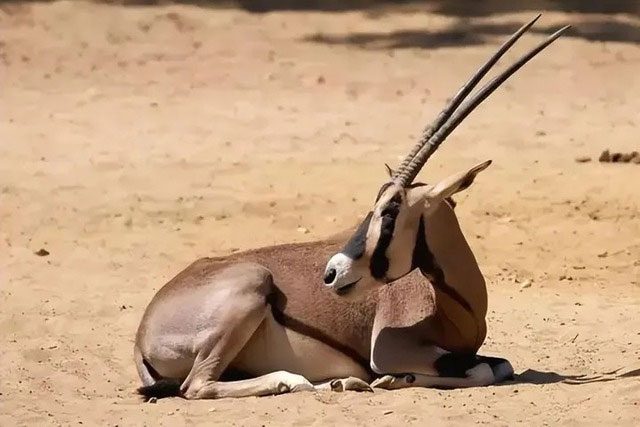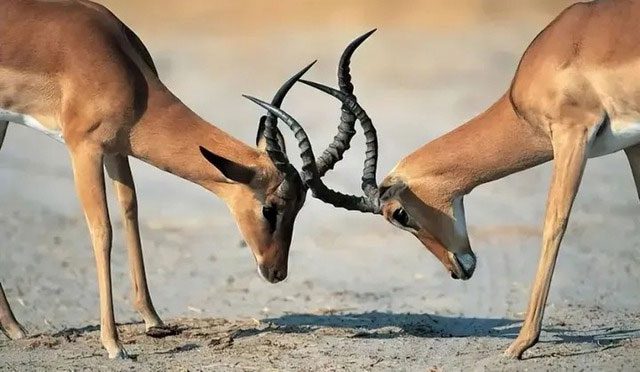Antelopes are a group of herbivorous animals belonging to the even-toed ungulates order and the Bovidae family, living across the continents of Asia, Africa, and North America.
Personality and Habits of Antelopes
The personality and habits of antelopes can be described as “nimble, agile, and alert.” As animals that inhabit vast grasslands and mountainous areas, antelopes require unique characteristics and habits to adapt to their environment and ensure their survival.
Antelopes are known for their exceptional speed. They are the fastest terrestrial animals, capable of running at speeds of up to 60 miles per hour. This speed serves as a self-defense mechanism for antelopes when they encounter danger. When they sense a threat, they immediately flee to safety. This ability to escape allows antelopes to survive in the wild and avoid becoming prey for predators.

Antelopes are among the fastest herbivores in the world, with some species capable of running at speeds close to 100 km/h. This astonishing speed raises curiosity about why antelopes are so fast.
The agility of antelopes is another important characteristic that aids their survival. They possess precise and rapid movement skills that allow them to navigate quickly through complex terrains. Antelopes can easily leap over obstacles in the grasslands and maneuver effortlessly across rugged mountain landscapes. This agility enables antelopes to efficiently search for food and water while also helping them evade potential predators.
The alertness of antelopes allows them to respond better to changes in their external environment. These animals are always vigilant and react quickly. When antelopes sense nearby danger, they immediately emit alarm calls to warn other antelopes. This high level of alertness helps antelopes form defensive groups, reducing the risk of being attacked by predators.

The body structure and physiological characteristics of antelopes provide them with extraordinary running capabilities. Antelopes have long and flexible limbs, with relatively light bones and body weight, enabling them to move faster while running. Their chest and lungs have also evolved to supply sufficient oxygen to their running muscles, thereby extending their running duration and distance.
The personality and habits of antelopes ensure their survival in grassland and mountainous environments. Speed, agility, and nimbleness are characteristics of antelopes, allowing them to adapt to complex and ever-changing natural environments.
Whether escaping threats by running fast, finding food through agile movement skills, or avoiding predators with intelligent reactions, antelopes demonstrate remarkable survival instincts.
Why Antelopes Reign as Kings of the Zoo
Antelopes are animals that inhabit mountainous and grassy regions and are known for their excellent adaptability and physical fitness. Moreover, antelopes have achieved the status of kings in zoos due to several unique advantages over other animal species.

Antelopes have sharp, wide-set eyes that can quickly detect movement and potential dangers. This enables antelopes to react swiftly and execute adaptive movements to avoid hidden threats while maintaining high speeds.
Their body structure and muscle development allow them to achieve incredible running speeds. In comparison, other animals such as bears and lions cannot compete with antelopes. Because of their speed, antelopes have a distinct advantage when searching for food and evading predators. In zoos, visitors are always attracted by the swift running of antelopes, as it presents a powerful and captivating sight.
Compared to other animal species, antelopes can change direction quickly and move nimbly in small spaces. This agility provides antelopes with an advantage in challenging situations, whether crossing grasslands or climbing steep hills. In the zoo, spectators can witness antelopes demonstrating incredible flexibility and agility in confined spaces, which is another significant reason they captivate audiences.

Antelopes also possess great endurance and coordination skills, which are crucial factors that help them maintain high speeds. When threatened, antelopes quickly form a formation and rely on coordinated actions and collaboration to enhance their chances of escape. During long sprints, each antelope takes turns leading, sharing fatigue and stress to ensure the safety and survival of the herd.
Antelopes also have excellent endurance. They can run at high speeds for extended periods without tiring. In contrast, other animals may become fatigued after running for a short while. This superior endurance gives antelopes a favorable position when fleeing from predators. In zoos, visitors often witness antelopes running continuously for long durations, showcasing their remarkable endurance and perseverance.
Antelopes also have exceptional vision and hearing. Their eyes and ears are highly sensitive and can timely detect potential threats. This allows antelopes to act early to protect themselves when facing predators. In the zoo, audiences often see antelopes observing their surroundings vigilantly and reacting quickly. This alertness makes antelopes an engaging attraction in zoos.

Antelopes have extremely fast reflexes. When faced with danger, they can quickly detect potential threats and react swiftly. This is due to their developed sensory systems, particularly their vision and hearing. Antelopes have large, sensitive eyes and ears, enabling them to rapidly perceive sounds and movements around them. Once they sense danger, antelopes immediately enter a heightened state of alertness and quickly flee the scene to ensure their safety.
Antelopes are undoubtedly amazing and admirable animals due to their exceptional speed, agility, endurance, and keen sense of smell and hearing. Whether running freely on the grasslands or showcasing their prowess in zoos, antelopes earn the affection and respect of everyone.


















































